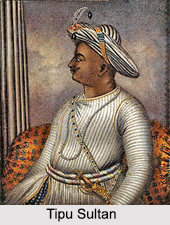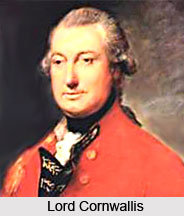 Mysore being the under Hindu rule, was once captured by Hyder Ali who made his territory full fledged with the Muslim power. This ruling scenario of Mysore was never accepted by the Marathas who always wanted to rule the territory and as a result they neither accepted the rule of Hyder Ali nor could the rule of Tipu Sultan satisfy them. Moreover in these circumstances, a stifled conflict was forming in between the Marathas and Tipu Sultan.
Mysore being the under Hindu rule, was once captured by Hyder Ali who made his territory full fledged with the Muslim power. This ruling scenario of Mysore was never accepted by the Marathas who always wanted to rule the territory and as a result they neither accepted the rule of Hyder Ali nor could the rule of Tipu Sultan satisfy them. Moreover in these circumstances, a stifled conflict was forming in between the Marathas and Tipu Sultan.
Sir John Macpherson, predecessor Lord Cornwallis had adopted the policy of intervention in the Mysore-Maratha War of 1786-1787. He offered to supply the Marathas with five battalions of troops to be employed anywhere either offensively or defensively. He justified a revision of the earlier policy of neutrality on the ground that the Company"s interests would be better served by joining a powerful party like the Marathas. Such a policy would reduce the military expenses of the East India Company and keep the Marathas on the English side should the French or Tipu Sultan cause any trouble to the English. The authorities in England made their stand still more explicit after their observation that they were completely satisfied with their possessions and will engage in no war for the purpose of further acquisitions.
When Lord Cornwallis took charge as the Governor-General in September 1786, he revised the policy of supporting the Marathas against Tipu Sultan. Macpherson"s policy would have involved the Company in a complicated political and military situation. It would be a breach of the Treaty of Mangalore with Tipu, which had enjoined strict neutrality on both parties in case either of them was at war with other Powers. If the English were to assist the Marathas, directly or indirectly then Tipu would be provided with a just ground to join the French. The latter"s delusion from Indian politics was the principal objective of British policy. Moreover, it was contrary to the spirit of the Pitt"s India Act just passed (1784), which was emphatic that the Company"s servants in India should avoid unnecessary interventions in the disputes of the native powers. Accordingly, Cornwallis informed the Marathas and the Nizam about the fact that he had revoked the previous engagements and withdrawn the offer of help to them. Cornwallis wrote to Dundas that Macpherson was guilty of a breach of an Act of Parliament in the offer, which he made of aid to Poona Government, and that he was guilty of basely degrading the national character, by quibbles and lies which he made use of to evade the performance of it. Cornwallis felt it difficult at first to extricate the Company from its commitments and declared their offering assistance to the Marathas as an awkward foolish scrape. On the pretext of strictly adhering to the subsisting treaties, he refused help to the Marathas and the Nizam.
The real cause for the stiff stand of Cornwallis was a real matter of concern. His policy was not out of any regard for Tipu Sultan, nor was he genuinely interested in maintaining the subsisting treaties, nor wedded irrevocably to a Pacific system. It was dictated purely as a measure of expediency. He too was as much conscious of the advan¬tages to the Company of a war of conquest like Macpherson. He wrote to the Court of Directors that the safety of the Company"s poss¬essions would best be preserved by letting the two formidable native powers engage in a war of exhaustion. But he differed from Macpherson as to the suitable occasion for intervention, for the finan¬cial and military position of the Company was far from satisfactory at the moment.
The condition of the Company"s military was in despicable state and the financial position was still worse. Added to this, a war would involve the Company in diplomatic complications as well, for by the Treaty of Paris, England and France were prevented from participating in a war among the native powers. Cornwallis was afraid that English assistance to the Marathas might force Tipu Sultan to seek French aid. As a result, the very purpose of going to war, namely to eliminate the French from the arena of Indian politics would be defeated. The effect of Macpherson"s promise of aid to the Marathas had already brought the French and Tipu Sultan closer together, and the latter had applied for 4,000 Europeans to remain constantly in his pay. These factors compelled Cornwallis to revise the decision of his predecessor.
Cornwallis adopted such a policy despite his full knowledge that it would disappoint the Marathas and invite their wrath on the Company. But he argued that British neutrality would shorten the war amongst the natives, and would render the European aid unnecessary. The Company would be relieved of the necessity of preparing for war. Besides, such a policy was in accordance with the instructions of the Home Government who had frequently directed their servants in India to observe strict neutrality in the disputes of Indian powers and to improve British relations with them by steady adherence to the subsis¬ting treaties between the Company and them.
 However, Cornwallis did not stick to this policy of neutrality for long. The moment the Company"s finances and military power improved, he began to envisage the reduction of Tipu"s power, whose successes against the Marathas and the Nizam further excited the jealousy of the English. According to the observation of Cornwallis, whether the Peshwa can place any reliance in Tipu"s adherence to the treaty after dissolution of the compact between the Peshwa, Madajee Bhonsle, Tukojee Holkar and Nizam Ali Khan, was equally a subject of conjecture at that time. On the pretext that Tipu might invade the Carnatic, Cornwallis direct¬ed Malet, the English agent at Poona, to enquire from Nana Fadnavis whether the Marathas were willing for an offensive alliance with the English against Tipu. The basis of such an alliance was the appropriation of Tipu"s territories, which were adjacent to the frontiers of the allies, after the conquest was completed. Being apprehensive lest the Maratha response should be unfavourable in the light of earlier British Government refusal of aid to them, Cornwallis assured Nana that the English were sincere in their offer this time. He also added that England had approved of such an alliance as well. Not only was Nana approached but an attempt was made by Cornwallis to win the other Maratha chieftains as well. Foster was authorized at Nagpur to invite Madajee Bhonsle to a defensive alliance against Tipu Sultan. Likewise Palmer was asked at Gwalior to induce Mahadji Sindhia to do the same.
However, Cornwallis did not stick to this policy of neutrality for long. The moment the Company"s finances and military power improved, he began to envisage the reduction of Tipu"s power, whose successes against the Marathas and the Nizam further excited the jealousy of the English. According to the observation of Cornwallis, whether the Peshwa can place any reliance in Tipu"s adherence to the treaty after dissolution of the compact between the Peshwa, Madajee Bhonsle, Tukojee Holkar and Nizam Ali Khan, was equally a subject of conjecture at that time. On the pretext that Tipu might invade the Carnatic, Cornwallis direct¬ed Malet, the English agent at Poona, to enquire from Nana Fadnavis whether the Marathas were willing for an offensive alliance with the English against Tipu. The basis of such an alliance was the appropriation of Tipu"s territories, which were adjacent to the frontiers of the allies, after the conquest was completed. Being apprehensive lest the Maratha response should be unfavourable in the light of earlier British Government refusal of aid to them, Cornwallis assured Nana that the English were sincere in their offer this time. He also added that England had approved of such an alliance as well. Not only was Nana approached but an attempt was made by Cornwallis to win the other Maratha chieftains as well. Foster was authorized at Nagpur to invite Madajee Bhonsle to a defensive alliance against Tipu Sultan. Likewise Palmer was asked at Gwalior to induce Mahadji Sindhia to do the same.
Thus, there was once again a change in the English policy which was alternating between neutrality and intervention. As per the records found in history, every Governor General was inclined to adopt a vigorous forward policy, but was sometimes restrained to do so only by the exigencies of the situation which would not every time guaran¬tee success to the British arms. The King of Mysore, Tipu Sultan, also actively tried to counteract these developments. He contacted Nana and prepared the ground for an Indian alliance. In support of this alliance, Nana opined that it was not the time of insisting on the reimbursement of the wrongs that had been made but to recover that part of the Carnatic conquests of the Chatrapati Shivaji which was now under the seize of the English.
As the Marathas always wanted to capture Mysore and establish their rule in the territory they could not stand Tipu in power. They knew that Tipu was in alliance with the French to strengthen his power and it was difficult to defeat Tipu without any help from the British military force. Moreover, the East India Company had a grudge against Tipu and they were trying to find a support to go against Tipu. It was known by the Company too that Tipu had made an alliance with the French. In the meantime, the Marathas took the queue. To strengthen their position, the Marathas joined hand with the British to extricate Tipu from the power of Mysore. Thus two different parties were formed, one being the Marathas with the East India Company and another French with Tipu. Though in the actual sense, no war took place in between two parties, a suppressed feeling of resentment was forming and this was the situation that gave rise to the conflict between two alliance parties.
Moreover, Tipu Sultan was in touch with the Nizam as well, who was interested in recovering the Guntur Sarkar. Before con¬cluding any positive alliance the parties agreed upon a truce for three years and six months. These developments indicate that the two parties, English and Tipu, were extremely suspicious of each other. There was some difference in the policies of these two parties. Whereas the English adopted an extremely flexible policy of either neutrality or intervention as it suited their convenience. Tipu was quite firm in his stand, and adopted a determined and consistent policy of opposition to the British. The Marathas and the Nizam had no such fixed policy, for they were motivated purely by their self-interest and joined any party that would advance their interest.






































